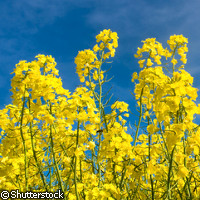Hormones key to oilseed rape riddle
Hormones are at the heart of a problem that causes between 10% and 25% of oilseed rape seeds to be lost before harvest, new research reveals. An international team of scientists describes the solution to the problem of 'pod shatter' in the latest edition of the journal Nature. Oilseed rape's tiny black seeds are, as the crop's name suggests, rich in oil which can be used for cooking, in margarines and for biodiesel. Furthermore, the substance that is left over after the oil has been extracted can be used in animal feeds. However, farmers and scientists have yet to work out how to control oilseed rape's seed dispersal mechanism. As a result, many seed pods shatter and shed their seeds before the crop is harvested. In the worst cases, up to 70% of seeds may be lost. In addition, these seeds may go on to grow and contaminate the next crop in the rotation cycle. Harvesting the seeds earlier is not a viable solution because some immature seeds, which are of a lower quality, may also be collected. In this latest study, the researchers looked at pod shatter in Arabidopsis thaliana, which is widely used by plant scientists and is closely related to oilseed rape. They focused their investigations on the narrow strip of cells along which the pod splits. The development of many plant structures is triggered by the presence of high levels of plant hormones such as auxin. However, in this case the opposite is true - it is an absence of auxin that drives the formation of the separation layer. Interestingly, this is the first time that the removal of a hormone has been implicated in the development of a structure or organ in either plants or animals. The researchers speculate that for a structure just a few cells across, it may actually be simpler to transport auxin out of the cells and keep them auxin free, than to create and maintain high concentrations of auxin in the cells. 'To our knowledge, a regulated minimum of a signalling molecule has not previously been reported in plants or animals, and thus provides a new concept in general hormone biology,' the researchers write. The scientists also identified a number of the genes involved in transporting auxin out of the separation layer at the appropriate stage of plant development. Furthermore, by inserting auxin into the separation layer, the researchers succeeded in preventing the seed pods from splitting. 'By artificially producing a hormone in a specific region of the fruit, we have stopped the fruit opening in the related model plant Arabidopsis, completely sealing the seeds inside,' explained Dr Lars Østergaard of the John Innes Centre in the UK. 'We need to refine the process for use in agriculture to reduce seed loss [while] still allowing them to be easily harvested.'



